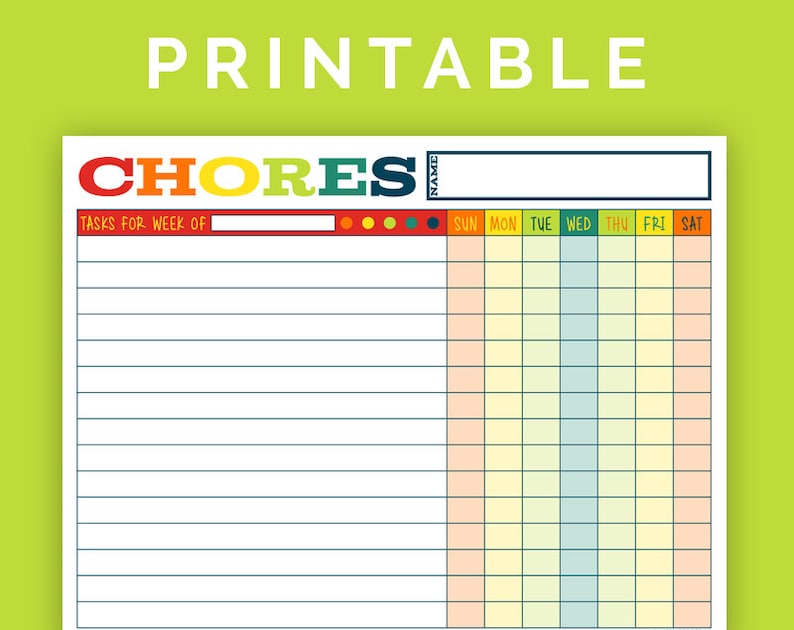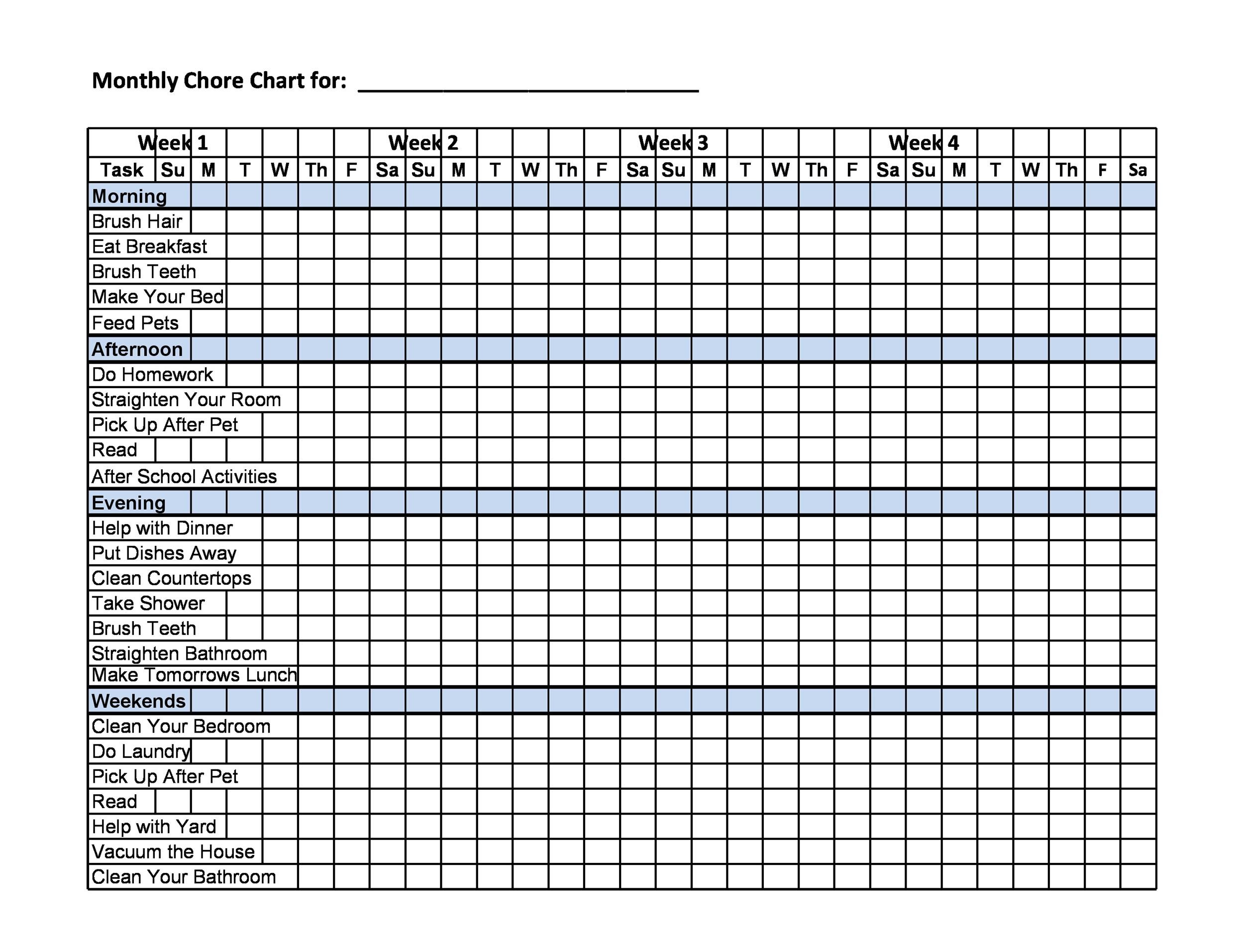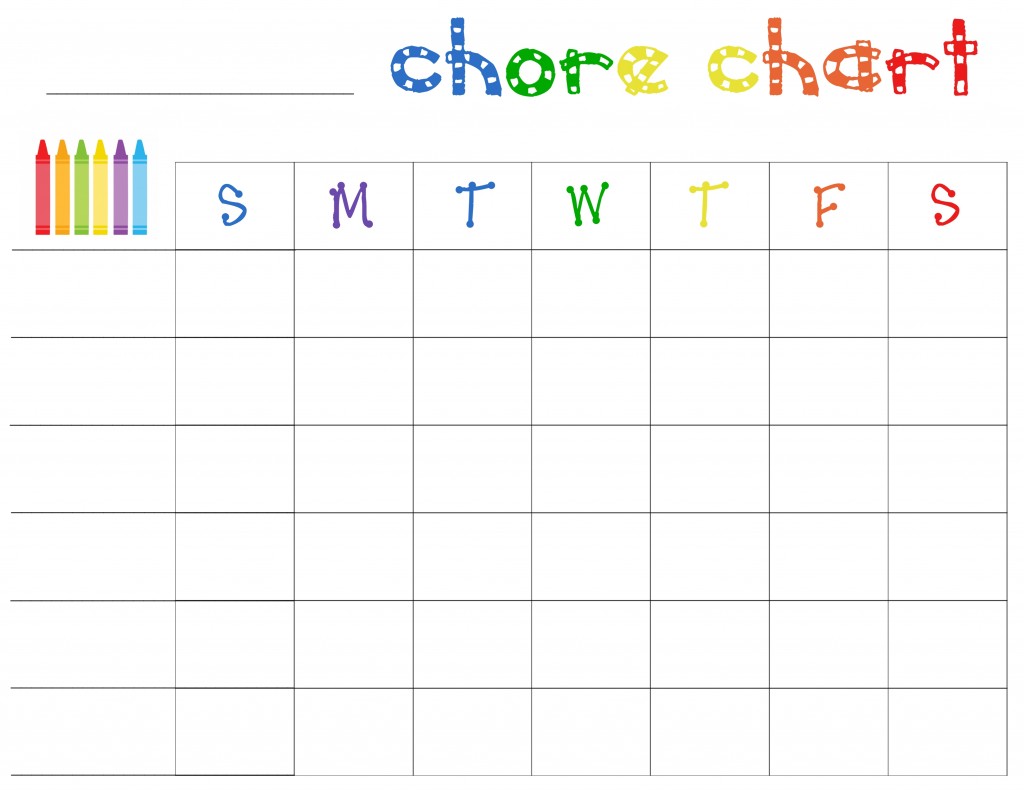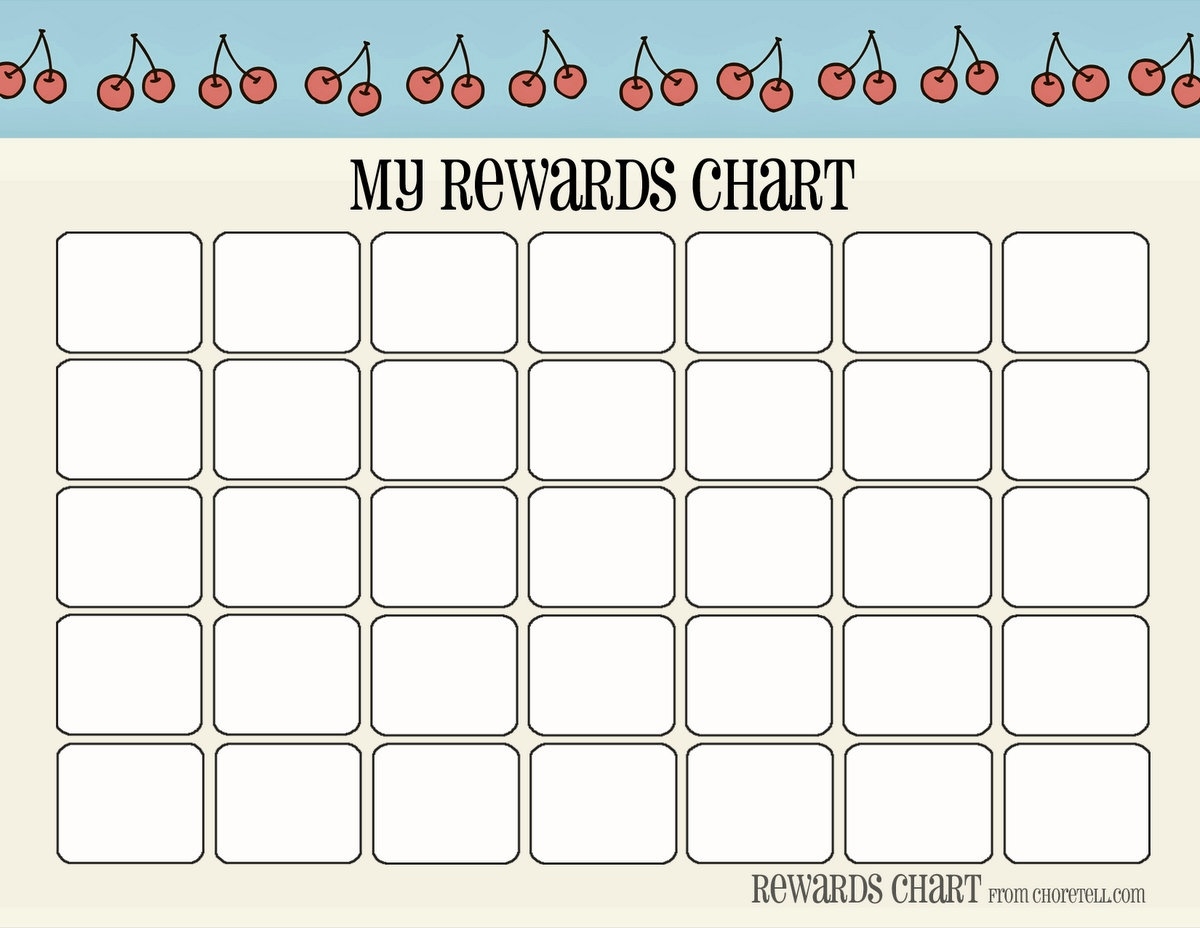Free printable chore chart is a game-changer when it comes to managing your household tasks. Whether you’re a busy parent or just looking for a more organized routine, this guide will walk you through the benefits, design tips, and age-appropriate chores to create a chore chart that works for your family.
Get ready to simplify your life and make chores a breeze!
Introduction to chore charts

A chore chart is a visual tool that helps individuals or families organize and track household tasks and responsibilities. It typically consists of a list of chores or tasks to be completed, along with spaces to mark when each task has been finished.
The purpose of a chore chart is to promote accountability, teach responsibility, and create a sense of structure and routine within the household.Using chore charts can bring several benefits. Firstly, they can help distribute and delegate household chores more efficiently, ensuring that everyone in the family contributes to the upkeep of the home.
This can alleviate the burden on a single individual and promote a sense of teamwork and cooperation.Additionally, chore charts can help teach important life skills, such as time management, organization, and accountability. By assigning specific tasks and setting deadlines, individuals learn to prioritize and manage their time effectively.
They also become more responsible for completing their assigned chores, as they can visually see their progress and take ownership of their responsibilities.Personally, I have found chore charts to be incredibly helpful in maintaining a well-functioning household. When I implemented a chore chart for my family, I noticed that everyone became more engaged and proactive in completing their tasks.
It created a sense of ownership and pride in our home, as we all contributed to its cleanliness and organization.
The benefits of using chore charts
Using chore charts offers numerous advantages for individuals and families. Here are some key benefits:
- Promotes accountability and responsibility
- Teaches important life skills
- Creates a sense of structure and routine
- Fosters teamwork and cooperation
- Reduces stress and workload
By promoting accountability and responsibility, chore charts ensure that individuals understand the importance of completing their assigned tasks. This helps develop a strong work ethic and a sense of responsibility towards the household.Chore charts also serve as a valuable tool for teaching important life skills.
If you’re looking for a fun and creative way to celebrate Mother’s Day, why not try making folding mothers day cards printable? These cards are a great way to show your love and appreciation for your mom. You can easily find printable templates online, like this folding mothers day cards printable , that will guide you through the folding process.
Once you have your template printed, simply follow the instructions to fold the card into a beautiful design. Add a heartfelt message inside and you have a personalized and thoughtful gift for your mom.
Through the process of planning, organizing, and completing tasks, individuals learn essential skills such as time management, prioritization, and attention to detail.Furthermore, chore charts create a sense of structure and routine within the household. By having a defined list of tasks and deadlines, individuals can establish a consistent routine and maintain a clean and organized living environment.Using
chore charts also fosters teamwork and cooperation. When everyone in the family contributes to the household chores, it creates a sense of unity and shared responsibility. This promotes a positive family dynamic and strengthens relationships.Lastly, using chore charts can help reduce stress and workload for individuals.
By distributing tasks evenly and ensuring everyone participates, the burden of household chores becomes more manageable and shared among family members.
Overall, incorporating chore charts into your household routine can bring numerous benefits, including accountability, responsibility, life skills development, structure, teamwork, and reduced stress.
Teaching your child the alphabet can be a fun and interactive experience. One way to make it even more engaging is by using a free printable alphabet chart. This chart provides a visual representation of each letter, making it easier for your child to learn and recognize them.
You can easily find a variety of free printable alphabet charts online, like this free printable alphabet chart . Print it out and hang it up in your child’s room or use it as a reference during learning activities. Your child will enjoy the colorful and vibrant illustrations while learning the alphabet.
Types of Chore Charts

Chore charts come in different types, each with its own advantages and disadvantages. Here are some common types of chore charts:
1. Printable Chore Charts
Printable chore charts are charts that can be printed out on paper or cardstock. They often come in the form of templates that can be customized to suit your specific needs. Printable chore charts are popular because of their simplicity and convenience.
They can be easily accessed and printed from the comfort of your own home. Additionally, printable chore charts allow for flexibility in terms of design and layout.
2. Digital Chore Charts
Digital chore charts are chore charts that are created and accessed electronically. They can be in the form of smartphone apps, computer programs, or online platforms. Digital chore charts offer the advantage of being easily accessible from anywhere with an internet connection.
They also often come with additional features such as reminders and progress tracking. However, they may require more initial setup and technical knowledge.
3. Magnetic Chore Charts
Magnetic chore charts are charts that can be attached to a magnetic surface, such as a refrigerator or a whiteboard. They are often made of magnetic materials or have a magnetic backing. Magnetic chore charts provide a visual and tactile way of tracking chores.
They can easily be rearranged and updated as needed. However, they may be limited in terms of customization options and may not be easily portable.
- Example of a Printable Chore Chart Template:
| Chore | Assigned To | Completed |
|---|---|---|
| Making the bed | John | |
| Taking out the trash | Sarah | |
| Doing the dishes | Emily |
Designing a printable chore chart: Free Printable Chore Chart

Creating an effective chore chart design is essential for its successful implementation. The design should be visually appealing and organized to ensure that it is easy to follow and understand. Here are some tips and guidelines to consider when designing a printable chore chart.
Importance of visual appeal and organization
A visually appealing chore chart can motivate individuals, especially children, to complete their tasks. By incorporating colors, graphics, and themes, the chore chart becomes more engaging and interesting. Additionally, an organized layout helps individuals easily navigate and locate their assigned chores.
- Use bright and vibrant colors: Colors can evoke emotions and create a positive atmosphere. Incorporate colors that are visually appealing and match the overall theme or aesthetic of the chore chart.
- Include relevant graphics or icons: Graphics or icons can make the chore chart more visually appealing and help individuals quickly identify their assigned tasks. Use simple and easily recognizable graphics that represent each chore.
- Choose a theme: Incorporating a theme can make the chore chart more fun and engaging. For example, a superhero-themed chore chart can make tasks feel like missions to be accomplished.
- Ensure readability: Use clear and legible fonts that are easy to read, especially for younger children. Avoid using fonts that are too fancy or difficult to decipher.
- Provide ample space: Leave enough space for individuals to write or check off their completed tasks. This allows for easy tracking and provides a sense of accomplishment.
Ideas for incorporating colors, graphics, and themes
- Color-coded system: Assign a specific color to each family member or individual, and use that color to represent their assigned tasks on the chore chart. This helps individuals easily identify their own responsibilities.
- Themed chore charts: Create chore charts that align with a specific theme, such as a garden-themed chart for outdoor tasks or a space-themed chart for cleaning tasks. This adds an element of fun and excitement to the chores.
- Reward system: Incorporate a reward system into the chore chart design. Use graphics or icons to represent rewards or incentives for completing tasks. This can motivate individuals to actively participate in their chores.
- Seasonal or holiday-themed charts: Change the design of the chore chart based on the season or upcoming holidays. This keeps the chore chart fresh and exciting throughout the year.
By following these tips and incorporating the right elements, you can design a printable chore chart that is visually appealing, organized, and effective in encouraging individuals to complete their tasks.
Age-appropriate chores

Assigning age-appropriate chores to children is an effective way to teach them responsibility, develop essential life skills, and encourage them to contribute to the household. It is important to consider the capabilities and maturity level of each child when assigning chores.
Here are some suggestions for age-appropriate chores for preschoolers, school-age children, and teenagers.
Preschoolers
Preschoolers are eager to help and learn new things. While they may not be able to handle complex tasks, there are several simple chores they can do with supervision and guidance. Some suitable chores for preschoolers include:
- Picking up toys and putting them in designated bins
- Dusting low surfaces like coffee tables and shelves
- Putting dirty clothes in the laundry hamper
- Watering plants (with assistance)
- Setting the table with napkins or utensils
School-age children
As children grow older, they become more capable of handling more responsibility. School-age children can take on chores that require a bit more independence and physical ability. Here are some suitable chores for school-age children:
- Making their bed
- Sorting and folding laundry
- Emptying small trash cans
- Feeding and taking care of pets
- Helping with meal preparation, such as washing vegetables or setting the table
Teenagers
Teenagers are capable of handling a wide range of chores and can take on more complex tasks. Assigning them chores that require more responsibility can help prepare them for adulthood. Here are some suitable chores for teenagers:
- Doing laundry, including operating the washing machine and dryer
- Cleaning bathrooms, including scrubbing the toilet and shower
- Mowing the lawn or doing yard work
- Cooking simple meals
- Running errands, such as grocery shopping or picking up dry cleaning
Assigning and rotating chores based on age and capability is important to ensure fairness and to gradually increase the level of responsibility for each child. Start with simple tasks and gradually introduce more complex chores as they grow older. It is also important to provide clear instructions and demonstrate how to perform each chore to set them up for success.
Implementing a chore routine

Implementing a consistent chore routine can help teach children responsibility, time management, and the importance of contributing to the household. Here are some strategies and ideas for establishing and maintaining a successful chore routine.
Setting expectations
To ensure a smooth chore routine, it is important to set clear expectations for your children. Clearly communicate what chores need to be done, when they need to be completed, and how they should be done. Make sure the expectations are age-appropriate and realistic for each child.
- Discuss the importance of chores and how they contribute to the functioning of the household. Emphasize that everyone in the family has responsibilities.
- Provide clear instructions and demonstrate how to properly complete each chore. Break down complex tasks into smaller steps if necessary.
- Set specific timeframes for completing chores. This could be daily, weekly, or monthly depending on the chore. Use a chore chart to visually represent the tasks and deadlines.
- Establish consequences for not completing chores or not meeting expectations. This could include loss of privileges or additional responsibilities.
Motivating children
Motivating children to complete their chores can be a challenge, but there are strategies that can help make it more enjoyable and rewarding.
- Make chores fun by turning them into a game or competition. Set a timer and see who can finish their chores the fastest or assign point values to each chore and reward the child with the most points at the end of the week.
- Offer praise and encouragement when children complete their chores. Recognize their efforts and let them know that their contributions are valued.
- Create a reward system. This could be a sticker chart, where children earn stickers for each chore completed, and when they reach a certain number of stickers, they receive a small reward. Alternatively, you could establish a chore currency system where children earn tokens or points that can be exchanged for privileges or treats.
- Consider implementing a rotating chore schedule. This way, children have the opportunity to try different chores and avoid getting bored or burnt out on a particular task.
Tracking progress and rewarding achievements
Keeping track of your child’s progress and rewarding their achievements can help motivate them to continue completing their chores.
- Use the printable chore chart to track completed chores. Have your child check off or mark each chore as they finish it.
- Regularly review the chore chart with your child to discuss their progress and provide feedback.
- Consider periodically revising the chore chart to add new tasks or increase the difficulty level as your child grows older and more capable.
- When your child consistently completes their chores and meets expectations, provide rewards or incentives as a way to acknowledge their efforts. This could be a special outing, a small gift, or extra privileges.
By implementing a consistent chore routine, setting clear expectations, motivating children, and tracking progress, you can create a positive and productive environment where children learn the importance of responsibility and contribute to the household.
Creating a chore chart system

Creating an effective chore chart system is essential for organizing and managing household tasks. It helps distribute responsibilities among family members and teaches children valuable life skills. Here are different methods for organizing and managing chore charts, ideas for involving the entire family, and suggestions for adapting the system as children grow older.
Methods for organizing and managing chore charts
- Create a physical chore chart: Design a chart using a whiteboard, poster board, or a printable template. Divide it into sections for each family member and list the chores assigned to them. Use stickers or markers to track completed tasks.
- Use a digital chore chart app: There are various chore chart apps available that allow you to create and manage chore assignments digitally. These apps often have features like reminders and rewards systems to motivate children.
- Rotating chore chart: Assign different chores to family members on a rotating basis. This method ensures everyone gets a chance to do different tasks and prevents anyone from getting stuck with the same chores every time.
Ideas for involving the entire family, Free printable chore chart
- Hold a family meeting: Gather everyone together to discuss the chore chart system. Explain the importance of sharing responsibilities and ask for input on chore assignments.
- Create a family chore schedule: Assign specific days or times for completing certain tasks. This encourages teamwork and accountability.
- Set up a reward system: Establish incentives for completing chores, such as earning points or tokens that can be exchanged for privileges or treats. This motivates family members to participate and make the chore chart system more engaging.
Suggestions for adapting the chore chart system as children grow older
- Increase complexity: As children grow older, assign them more challenging tasks that align with their abilities. This helps them develop new skills and take on greater responsibilities.
- Introduce financial incentives: For older children, consider attaching monetary rewards to certain chores. This teaches them about earning money and financial responsibility.
- Encourage autonomy: As children become teenagers, give them more freedom to choose their own chores within certain guidelines. This fosters independence and decision-making skills.
Troubleshooting common challenges

When using chore charts, there can be some common challenges or obstacles that you may encounter. Here are some strategies to help overcome resistance or lack of motivation, as well as tips for addressing conflicts or disputes related to chore responsibilities.
Resistance or Lack of Motivation
It is not uncommon for children to resist or lack motivation when it comes to doing chores. Here are some strategies to help overcome this challenge:
- Set clear expectations: Clearly communicate the importance of completing chores and the benefits that come with it. Make sure your child understands why they need to do their chores.
- Make it fun: Find creative ways to make chores more enjoyable. You can turn cleaning into a game or play some music while doing chores.
- Reward system: Consider implementing a reward system to motivate your child. Offer small rewards or incentives for completing chores consistently.
- Lead by example: Show your child that you also participate in household chores. When they see you doing chores willingly, they may be more motivated to do the same.
Conflicts or Disputes
Conflicts or disputes can arise when it comes to chore responsibilities. Here are some tips for addressing these conflicts:
- Clear communication: Have open and honest discussions with your family members about chore responsibilities. Make sure everyone understands their roles and expectations.
- Rotate chores: Consider rotating chores among family members to avoid conflicts. This way, everyone gets a chance to do different chores and no one feels burdened with the same tasks all the time.
- Problem-solving: Encourage your family members to come up with solutions together when conflicts arise. Teach them how to communicate effectively and find compromises.
- Flexibility: Be open to making adjustments and compromises when necessary. Sometimes, unexpected situations or events may require changes in chore responsibilities.
